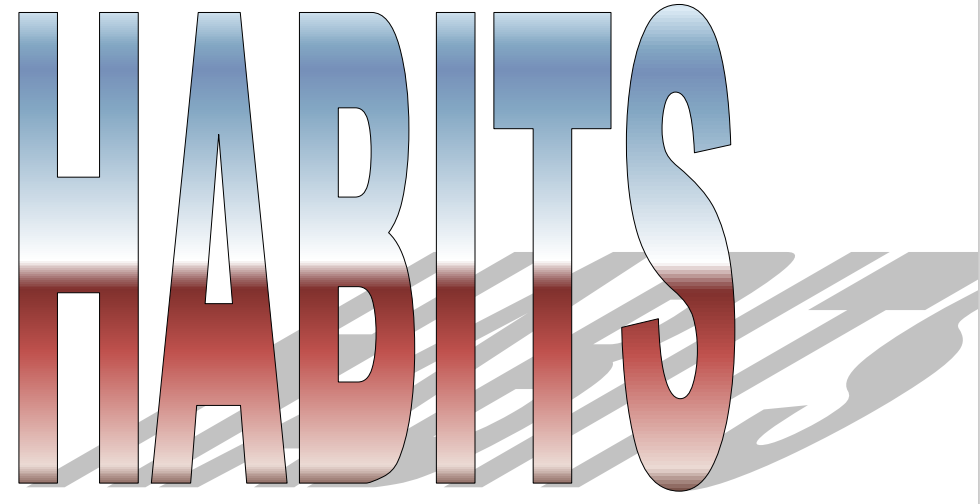A habit is defined as a settled or regular tendency or practice, especially one that is hard to give up. According to experts with Psychology Today, habits form when new behaviors become automatic and are performed with minimum conscious awareness. That’s because “the behavioral patterns we repeat most often are literally etched into our neural pathways.”
Neuroscientists have traced our habit-making behaviors to a part of the brain called the basal ganglia, which also plays a key role in the development of emotions, memories and pattern recognition. Decisions, meanwhile, are made in a different part of the brain called the prefrontal cortex. But as soon as a behavior becomes automatic, the decision-making part of your brain takes a break.
A example of this would be locking your door every time you enter the house. You have done this for so long, it becomes automatic. You may wonder when you go to bed, if you remembered to lock the door and might even go and check and of course you did.
In the book, The Power of Habit: Why We Do What We Do in Life and Business, Charles Duhigg explains the science of habits and how to change them. “Habits can be changed if we understand how they work.”
Throughout our lives, we develop good and bad habits. Habits can form without a person intending to acquire them, but they can also be deliberately created or eliminated depending on one’s goals. Regardless of the type of habit, the development process is the same. Understanding this process may be beneficial, as it demonstrates how we can change bad habits into good habits.
MIT researchers discovered a three-step neurological pattern that forms the core of every habit. The first step is cue. It is a trigger that tells your brain to go into automatic mode and prompts the behavior to unfold. The second step is routine, which is the behavior itself and the action you take. The last step is reward. It helps your brain determine if a particular habit loop is worth remembering or not. Generally, habits have immediate or delayed rewards. Habits with immediate rewards are easier to pick up and condition, whereas those with delayed rewards are more difficult to commit to and maintain.
To further explain these steps:
Cue-is the trigger that sets off the habitual behavior. These cues vary widely but usually fall under one of the following categories: location, time, current emotional state, people around you, your last action. For example, most people get up at a certain time of day(time cue) and then either make coffee or take a shower (last action cue). When you feel sad (emotion cue) you may eat. When you start your car (location cue) you put on your seat belt.
Routine- is the habit, or repeated behavior. Habitual behaviors often happen automatically, though you probably made a conscious choice to pursue that action the first few times you did it. Over time, this routine becomes more automatic thanks to the final component of the habit loop, the reward.
Reward- refers to what the behavior does for you. Rewards reinforce routines and help keep habits firmly in place. Some rewards can benefit you. Brushing your teeth after breakfast, for example, rewards you with a clean, fresh mouth. A habit of reading before you go to bed, helps you to relax and fall asleep easier. Less beneficial rewards can reinforce habits you don’t want to keep, like smoking when you feel bored or nervous. But once your brain begins to associate that specific behavior with a reward (in this case, relief from boredom or stress), you’ll eventually develop a craving for the behavior, even if you don’t realize it.
Many of us can remember routines we formed as young children, such as taking a bath and brushing our teeth before bed. This routine was a habit that gave us a feeling of safety and security. The same is true for habits we form as adults, they give us a sense of security and being asked to change our actions can trigger emotions such as anger, frustration, depression, fear and anxiety. Change is hard for most people, it is threatening, and most of us are resistant to making changes even if the change would be more beneficial to our health and quality of life.
Making changes is especially hard when a habit has become an addiction. Though similar to a habit, addiction is much stronger than a habit as it affects a person’s mental, physical health, as well as daily functioning. According to the American Psychiatric Association, an addiction causes people to have an “intense focus on using a certain substance, such as alcohol or drugs, to the point that it takes over their life.” Addiction literally rewires your brain, making it hard to overcome. It teaches the brain that pursuing and engaging in a certain substance or activity, even if the behavior is harmful to the person and their overall quality of life, will produce dopamine, causing a feeling of euphoria. This causes the brain to consistently seek out the same substance or behavior over other sources of pleasure, such as spending time with family, and friends. Although addictive habits are stronger and hard wired they too can be overcome. The process just may take longer. Like mentioned above, people are resistant to change and making changes. When a person’s brain is telling them to keep engaging in the previous behavior to get pleasure, is especially hard. This is why people overcoming addiction need to surround themselves with supportive people. Support is helpful while they work on changing the addiction habit to healthy, life giving habits such as: exercise, eating healthy, managing money, being mindful, going to work and spending time with friends and family.
Restoration Ranch is here for you if you need a change!
Food for thought-We are what we repeatedly do. Excellence, then, is not an act, but a habit.–Aristotle
~Teri Storm

